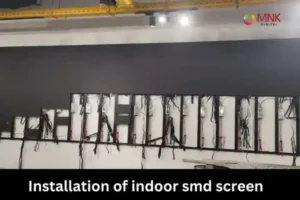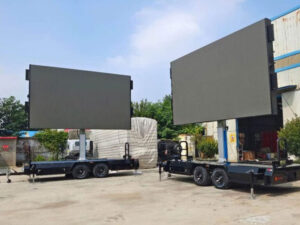MNK DIGITAL

Learn Installing Indoor SMD Screens the ins and outs of installing SMD screens in indoor environments with our comprehensive guide. From pre-installation steps to testing, we’ve got you covered.
SMD screens have emerged as versatile and impactful solutions in digital displays, offering vivid visuals and dynamic content. MNK Digital, a leading indoor and outdoor SMD screens provider, presents a comprehensive guide to installing indoor SMD screens. From understanding their significance in indoor environments to navigating the installation process, this guide aims to equip you with the knowledge needed for a seamless setup.
Importance of SMD Screens in Indoor Environments:
SMD screens have revolutionized indoor advertising, communication, and entertainment. Their high-resolution displays, vibrant colors, and flexibility make them ideal for indoor applications. From retail spaces and corporate offices to event venues and public facilities, indoor SMD screens enhance engagement and leave a lasting impression on viewers.
Method of Installation:
Installing indoor SMD screens requires careful planning and execution to ensure optimal performance and longevity. The installation process can be divided into three main phases: pre-installation steps, installation process, and post-installation steps.
Pre-Installation Steps:
Before embarking on the installation process, thorough preparation is essential. Begin by assessing the installation site and determining the placement of the SMD screens. Consider factors such as viewing angles, ambient lighting, and structural support. Next, ensure that all necessary equipment and tools are readily available. This may include mounting brackets, cables, power sources, and safety gear. Coordinating with relevant stakeholders, such as electricians and contractors, is crucial to streamline the installation process.
Installation Process:
With the pre-installation groundwork, install SMD screens according to the manufacturer’s guidelines and specifications. Begin by mounting the screens securely onto the designated surface, ensuring proper alignment and stability. Connect the screens to power sources and any required input devices, such as media players or content servers. Pay close attention to cable management to minimize clutter and potential hazards. Once the physical installation is complete, test the functionality of the screens to verify proper operation.
Post-Installation Steps:
After the SMD screens are installed and operational, conduct a final inspection to address any remaining issues or adjustments. Ensure that all connections are secure and that the screens display content accurately. Document the installation process for future reference and maintenance purposes.
Post-Installation Steps Include:
- Calibration: Fine-tune display settings such as brightness, contrast, and color balance for optimal performance. This ensures that the screens deliver the desired visual impact and maintain consistency over time.
- Content Integration: Integrate content management systems or media players to streamline content updates and scheduling. This step involves configuring the software interface to deliver and manage the content of SMD screens seamlessly.
- User Training: Provide training sessions for staff members responsible for operating and maintaining the SMD screens. This ensures that personnel are proficient in utilizing the screens’ features and addressing any minor issues that may arise.
- Maintenance Schedule: Establish a regular schedule to keep the screens clean and functioning efficiently. This may include periodic inspections, cleaning of the display surface, and software updates to address performance issues or security vulnerabilities.
Testing Your Setup:
Thorough testing is essential to ensure the reliability and performance of your indoor SMD screens. Evaluate various aspects of the setup, including image quality, color accuracy, brightness levels, and responsiveness to content changes. Test the screens under different lighting conditions and viewing angles to assess visibility and readability.
Testing Your Setup Should Include:
- Image Quality: Ensure images and videos are displayed clearly without distortion or pixelation.
- Color Accuracy: Verify that colors appear vibrant and accurate to life across the entire display.
- Brightness Levels: Adjust brightness settings for optimal visibility in varying lighting conditions.
- Content Responsiveness: Test the screens’ responsiveness to content changes, transitions, and interactive elements.
- Viewing Angles: Assess visibility from different angles to ensure optimal viewing for all audience members.
Conclusion :
Installing indoor SMD screens requires meticulous planning, precise execution, and thorough testing. By following the steps outlined in this guide, you can achieve a successful installation that maximizes the impact of SMD technology in indoor environments. MNK Digital remains committed to providing innovative solutions and expert guidance to enhance your digital display experience.
FAQs
Can indoor SMD screens be installed on any surface?
While indoor SMD screens can be mounted on various surfaces, it’s essential to ensure adequate support and structural integrity to prevent damage or instability.
How do I choose the right size and resolution for indoor SMD screens?
Consider factors such as viewing distance, available space, and intended content when selecting the size and resolution of indoor SMD screens. Consult with MNK Digital experts for personalized recommendations based on your specific requirements.
What maintenance is required for indoor SMD screens?
Regular maintenance, including cleaning, software updates, and component inspections, is crucial to ensure the continued performance and longevity of indoor SMD screens. MNK Digital offers maintenance services to keep your screens operating at their best.
How long does it typically take to install indoor SMD screens?
The installation duration varies depending on factors such as the display system’s size, setup complexity, and site-specific considerations. However, a professional installation team can complete the process within a few days to a week.
Can indoor SMD screens be installed in any indoor environment?
While indoor SMD screens are versatile and can be installed in various indoor settings, environmental conditions, space constraints, and regulatory requirements may impact installation feasibility. It’s essential to consult with experts to assess suitability for specific environments.
For More Info Realted To Smd Screens Read More





